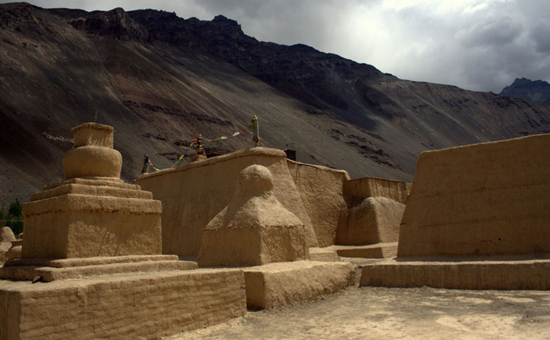- Article tells about the importance of Tabo Monastery, how it evolved and its importance in Buddhist religiosity, artistry and architecture.
Transcending
the cruel scourge of time, the Buddhist frescos and murals in the caves of
Ajanta and Ellora – like Prince Siddhartha with Blue Lotus, The Divine Dream of
Mayadevi, Yashodhara and son Rahul have been mesmerising us as the epitomes of
India’s Buddhist spirituality and artistic consciousness. Amidst the snowy,
tranquil expanses of the gigantic Himalayas, such holiness and aroma of
Buddhist artistry as well as spiritualism are also evident within a Buddhist
monastery – the Tabo Gumfa. Located at the high altitude and picturesque Spiti
Valley, within the Devabhumi of India – the state of Himachal Pradesh.
The
residents inside Tabo Monastery are principally of the Gelukpa Community, who
always believe in that eternal chanting - “Om
Mani Padme Hum” – Behold that Gem of wisdom within the Divine lotus that
would terminate your moral stigmas, evil and unsated desires, anguish,
superstitions and envy. The Tabo Gumfa is saved from torrential downpour and
subsequent landslides since the Spiti Valley is saved, from the monsoon wind,
by the Himalayan slope.
This
Tabo Monastery had been set up in the year 996, under the guidance of one of
the stalwarts in Tibetan Buddhism - Mahaguru
Ratnabhadra or Rin Chen Tsang Po.
The Monastery comprises of nine temples with an ancient Buddhist art gallery,
exquisite murals and ‘Stacco’ series of pictures depicting Jataka Tales, life
of lord Buddha and the activities of his celebrated disciples - Ananda, Upali,
Sariputta and Maudgalyayana.
This
Tabo Gumfa is India’s sole, one stone or Monolithic structure, the
architectural grace of which may be compared to those of England’s Windsor
Castle or Tamil Nadu’s Brihadeshwara Temple. This Tabo Monastery, located to
the northern bank of the Spiti River and at 50 kms. Southeast to the city of
Kaaza has been honourably included within the list of World Heritage sites by
the UNESCO. At present, Tabo Monastery is being headed by the monk, Sensup Serking
Rimpoche.
 A section of Tabo monastery. Pic by V Shourie.
A section of Tabo monastery. Pic by V Shourie.
Article
was first published in Bhavan’s Journal Mumbai.
Tabo
Monastery was heavily damaged in the 1975 earthquake. It was then renovated
with a new prayer assembly hall (Dukhang).
His Holiness Dalai Lama (Tenzin Gyatso)
arrived at this remote monastery in 1983 to observe the ‘Kaal Chakra’ festival
for the happy and prosperous life of the local residents. The monastery’s
renovation work is currently being supervised by the Archaeological Survey of
India (ASI). The Tabo Gumfa has also been declared as a ‘National Historic
Treasure’.
Tabo
Monastery is encircled with snow melted brooks, boulders and small hamlets.
About 300 - 400 impoverished, but selflessly happy people have been residing in
the small, mountainous villages. They have been protecting the pristine
environment from the toxic elements like plastics and polythene. A helipad and
an agrohorticultural garden have also been set up here.
The
frescos of the life of land Buddha have been painted on the walls of Tabo
Monastery with the help of herbal colours. Buddhist religion spread in Spiti
Valley with the enterprise of Guru Padmasambhaba, whose idealism spawned the
establishment of this Tabo Monastery in the later period.
Padmasambhaba fused the
Mahayana and Tantricism to evolve the Vajrayana
school of Buddhism. He also set up a Buddhist monastery in Saamo to the south
of Lhasa, as the forbear to Tabo Monastery in 779 C.E.
The
Tabo Monastery was then set up with the enterprise of the visiting Bengali
philosopher from Dhaka (Bikrampur), Bangladesh Pandit Ateesh Dipanka Shrigyan
and Buddhist ascetic Milarepa. (see link 3 to read about Pt Ateesh)
There
are 23 small shrines (Chhorten) within the Tabo Monastery, a cellar for monks
and a nunnery. The earthen boundary of Tabo Monastery measures 6000 square
meters. The central temple of Tabo Monastery is Sag - La - Khang (Temple of the Enlightened God). Here, the
four-faced primitive Buddha (Adi Buddha) or Bhairokana
is worshipped. This incarnation of Lord Buddha is believed to have created
himself. Apart from this idol, there are the images of 33 more deities in this
temple.
 Ki Monastery Spiti Valley. Pic by S Nayyar.
Ki Monastery Spiti Valley. Pic by S Nayyar.
The
Golden Temple was renovated in the 16th Century by then ruler of Ladakh, Tsenga
Namgiyal. There is a huge oil painting or Bhairokana and the paintings of eight
Bodhisattvas within the Mystic Mandala Temple or Deeksha Mandir.
A 20-feet-high, bronze idol of Lord Buddha and some mural
paintings from Lhasa’s Potala Palace are found within the Tabo Monastery’s
Bodhisattva Maitreya Temple. Ateesh Dipankar’s disciple, Dromton also built a
temple within Tabo Monastery where the icons of Lord Buddha and his two
favourite disciples, Sariputta and Maudgalyana are preserved, along with
wonderful ceiling paintings. Tabo Monastery also contains the protector of Geluk
Patribe, Mahakala Vajrabhairav’s
temple.
In
respect of Buddhist religiosity, artistry and architecture, Tabo Monastery of
the Spiti Valley may also be synonymous to Bharhut
and Karla Chaitya, Dalada Maligawa Pagoda in Sri Lanka and Shwe Dagon Pagoda in Myanmar. Tabo
Monastery can be reached through an ardous, exciting, 350 km journey through
Shimla, Narkanda, Rampur, Kulu, Manali, Rohtang Pass, Wangtu, Sang La and
Kunzum Pass.
This
article was first published in the Bhavan’s Journal, 15 February 2021 issue.
This
article is courtesy and copyright Bhavan’s Journal, Bharatiya Vidya Bhavan, Mumbai-400007. eSamskriti has
obtained permission from Bhavan’s Journal to share. Do subscribe to the
Bhavan’s Journal – it is very good.
Also see pictures of / read
1. Spiti Valley
2. Tabo
Spiti
3. Atisha’s
Spiritual Journey to Tibet via Sumatra
4. Ajanta
Caves 20 to 26
5. Ajanta
Caves 16, 17
6. Buddhist
Caves Ellora
7. Spiti
Valley a Hidden Paradise